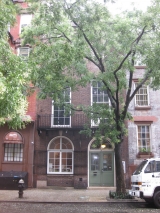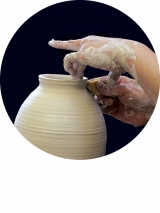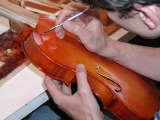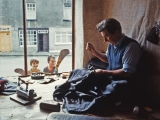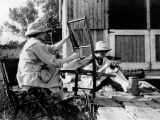Search
Org/Edu
Org/Edu
In a century of providing ceramics instruction, Greenwich House Pottery (GHP), located on a picturesque street in New York City’s historic Greenwich Village neighborhood, evolved from a modest program aimed at acculturating poor immigrants and providing training in a marketable skill to a nationally recognized workplace and showcase for contemporary ceramics. Begun in 1909 as a program of
a settlement house founded in 1902, the pottery, under its first director, Maude Robinson (from 1911 to 1941), an artist with a Newcomb College background, attracted patronage
as well as students from the city’s social elite, and accepted commissions and sold works ...
Org/Edu
The Wood Turning Center in Philadelphia is no more. But that's no cause for alarm, says executive director Albert LeCoff. As his organization rounds the corner on 25 years, it's been rechristened the Center for Art in Wood, a name change designed to keep up with the evolution of wood art. "We've always encouraged artists to use whatever processes or materials they needed to express themselves," LeCoff says. "The field has grown well beyond just woodturning."
The center is growing with it. The fresh name is a reflection of its new, business-savvy strategic plan, which has already put the nonprofit in ...
Org/Edu
In 1978, nine ceramists—potters and sculptors—in the Baltimore area sought to establish a center for artists, students and the public to experience and learn about clay, a collective space to work in, teach and exhibit. The group’s formulation of their vision to representatives from a city planning agency earned them the use of a historic library building in the Mt. Washington neighborhood of Baltimore, and after a renovation of the building to their purposes, the nonprofit Baltimore Clayworks opened its doors in November 1980. Twenty years later, a donated 1880s stone building across the street called the Provincial House was ...
Org/Edu
Craftsmanship is the watchword of the North Bennet Street School in Boston, which offers rigorous training in eight disciplines. Located in an early-19th-century brick building near the historic Old North Church, the school has been training people for employment for 125 years, pioneering the concept of placing students in a classroom with a master to learn a trade. The Boston philanthropist Pauline Agassiz Shaw opened the school as the North End Industrial Home in 1880 to serve immigrants, and in 1885, when the focus shifted from employment opportunity to education, it was renamed the North Bennet Street Industrial School. Historical ...
Org/Edu
What role does digital production play in craft, a field that reveres skilled handwork? It's a question that Haystack Mountain School of Crafts, celebrating the campus' 50th anniversary this year, has been discussing for the past decade, starting with 2002's symposium "Digital Dialogues: Technology and the Hand," a partnership with the Massachusetts Institute of Technology.
Now Haystack has taken that dialogue to the next level. Thanks to an anonymous $145,000 grant, the campus now has a brand-new digital "fab lab" - short for fabrication laboratory - with a laser cutter, CNC (computer numerical controlled) router, and precision milling machine, set to ...
Org/Edu
Produced between 1978 and 1991, Hands is a reminder of the richness of Ireland's traditional crafts. ...
Org/Edu
Few have lived life as happily steeped in materials and handwork as James Bassler, textile artist and professor.
Bassler is a maker to his core, as evidenced by his extraordinary art tapestries, prized by collectors, and his eloquence on the subject of craft - down to the charming, unconscious way he peppers conversation with phrases like "weave that in" and "grasping at straws."
"I had them in the palm of my hand," he says, describing the time he gave craft materials to a class of indifferent seventh-graders and watched them grow excited about learning. It was 1963, and he was in ...
Org/Edu
The appeal of Ox-Bow, School of Art and Artists' Residency, in Michigan, has been its bucolic seclusion and scenic beauty, the better to foster its mission “to serve as a haven for the creative process through instruction, example and community.”
Ox-Bow was founded in 1910 by Frederick Fursman and Walter Marshall Clute, artists associated with the School of the Art Institute in Chicago (SAIC) who sought a respite from their clamorous city (and from the formal ideas of the Institute) and found it in Saugatuck, a town surrounded by dunes, forests, lakes, rivers and a lagoon. There they began teaching summer ...
Org/Edu
If, as Emerson said, “an institution is the lengthened shadow of one man,” then it might not be a stretch to say that the Racine Art Museum is the shadow of Bruce W. Pepich, its executive director and curator of collections, now celebrating his 35th year at this institution.
Opened in 2003, in a handsomely renovated building in downtown Racine, WI, RAM is one of the foremost museums in the country dedicated to contemporary craft. It is an outgrowth of the Charles A. Wustum Museum of Fine Arts, a modest house museum founded in 1941 some distance from downtown, with ...
Org/Edu
There's a lot of buzz these days about innovation and the benefits of creative, right-brain thinking-the kind artists do-for business: The Art of Innovation, by Tom Kelley of the design firm IDEO, is a best-seller; "The MFA is the new MBA," asserts author and cultural commentator Daniel Pink.
So where does craft fit into the conversation? Front and center, according to Denise Mullen, new president of the Oregon College of Art and Craft.
"It's a very interesting time for craft, on a lot of levels," says Mullen, whose resumé includes leadership roles at the Alberta College of Art + Design and the ...
Departments
Blog
Tags

